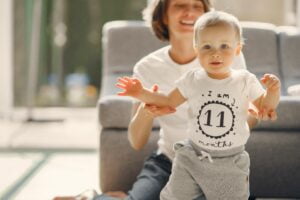7 Key Stages of Crawling: A Comprehensive Guide

Crawling is an important milestone for babies as it helps them develop crucial physical and cognitive skills. As parents, understanding what to expect as your babies beings to move will help you know what to expect and how to make your home safe. In this article, we will explore the typical stages your baby will go through as they begin to move, what signs to look out for and when to be concerns and how to make your environment safe for a little one one the move!
When do babies begin to crawl?
Babies typically begin to crawl between the ages of 6 and 10 months, although there can be a lot of variation in the ages at which this happens. The exact timing can depend on lots of factors, including the baby's strength, coordination, and overall development.
Before crawling, babies usually go through important stages such as tummy time, rolling, and scooting, which help them build the necessary muscles and skills. It's important to remember that every baby is unique and will reach milestones at their own pace. Some babies may start crawling earlier, while others may take a little longer.
What are the stages of crawling?
Crawling is an important milestone in a baby's developmental journey, marking their transition into independent mobility. As babies learn to navigate the world around them, they progress through several distinct stages of crawling. From the initial stages of tummy time and rocking to the advanced techniques of crawling on all fours and exploring different surfaces, each stage brings new physical and cognitive challenges for babies to overcome.
Understanding these stages not only allows parents to appreciate the remarkable process of their child's development but also enables them to provide the necessary support and encouragement along the way. Join us as we delve into the fascinating stages of crawling and explore the significant benefits they offer in shaping a baby's growth and exploration.
The Pre-Crawling Stages
Tummy Time

During tummy time, babies strengthen their neck, back, and shoulder muscles by lifting their heads and chests while lying on their stomachs. Rolling and pivoting serve as precursors to crawling, helping babies develop core muscles and spatial awareness.
Rocking
In the rocking stage, babies will begin to rock back and forth on their hands and knees. This helps them build strength in their arms and legs and prepares them for the next stage of crawling.
Early Crawling Phases

Scooting
During the scooting or belly crawl stage, babies will begin to move around on their stomachs by using their arms to push themselves forward. This helps them build strength in their upper body and teaches them how to move in a straight line.
Commando Crawling
In the commando crawling stage, babies will start to crawl on their stomachs using just their arms to move themselves forward. This helps them build strength in their upper body and develops their coordination.
Advanced Crawling Stages

Once babies have mastered commando crawling, they will move on to crawling on their hands and knees. This is the typical crawling position that most babies use to move around.
One-Knee Crawling
Some babies may develop a one-knee crawling style, where they use one leg to push off while the other leg stays stationary. This helps them build strength in their legs and improves their balance.
Crawling with Speed
As babies become more confident crawlers, they will start to crawl with more speed and fluidity. They may even start to crawl up stairs or climb on furniture.
What are the Signs your Baby is Ready to Crawl?

Recognising signs that your baby is ready to crawl can help you provide the necessary support. Look for strong head control, pushing up on arms, and rolling as indications of motor readiness. Curiosity and exploration, demonstrated by showing interest in moving towards objects, also signal their preparedness. Gradual improvement in gross and fine motor skills and individual variations in development should be considered as well.
How can you Encourage a Baby to Get Moving?

To foster your baby's crawling journey, it's crucial to provide a safe and conducive environment. Clear obstacles and create a baby-proof space, ensuring appropriate flooring and supervised play areas.
Offer as many opportunities for tummy time and floor play, engaging with your baby to encourage movement. Incorporate toys and objects of interest to motivate crawling and limit the use of walkers or other assistive devices. Celebrate and support your baby's progress and efforts, creating a positive and encouraging atmosphere.
When to Worry about Delayed Crawling?

While it's important to remember that every baby develops at their own pace, there may be instances when delayed crawling could raise concerns. If a baby has not shown any signs of attempting to crawl by the age of 12 months or is significantly behind their peers in achieving other motor milestones, it may be worth discussing with your doctor. Additionally, if a baby shows limited mobility, consistently favours one side of their body, or displays other physical abnormalities or developmental delays, it is advisable to seek medical advice. Keep in mind that delayed crawling alone may not necessarily indicate a serious issue, as some babies bypass crawling altogether and move straight to other forms of locomotion, such as cruising or walking. Nonetheless, it is always better to address any concerns promptly and seek professional advice from your doctor to ensure the baby receives appropriate evaluation and support if needed.
Beyond Crawling: Transitioning to Walking

Crawling serves as a bridge to the exciting world of walking. Understanding the connection between crawling and walking is important. The pre-walking stages, such as cruising, standing, and taking first steps, are significant milestones that follow crawling. Continue to provide support and encouragement during this transition, ensuring a safe environment for your baby's explorations.
Take Homes
Crawling is an important milestone for babies and helps them develop important physical and cognitive skills. By understanding the seven stages of crawling, you can better understand your baby's development and provide the support they need to progress through each stage.
We hope you found this article useful. Did you know that the Poppet community is a great place to find more helpful tips and resources for your family as well as flexible childcare from local parents and approved providers, all at the touch of a button. Register here today!
And here’s a list of other great resources to keep your family healthy and well
https://www.healthychildren.org/
https://www.nidirect.gov.uk/conditions/childhood-illnesses
https://www.sja.org.uk/get-advice/first-aid-advice/paediatric-first-aid/
https://firstaidchampions.redcross.org.uk/primary/first-aid-skills/
https://www.healthhub.sg/programmes/183/parent-hub
Disclaimer: We hope this helps your family if your little ones are unwell. Please remember this article is for education purposes and does not constitute medical advice. You should seek advice from a trained medical professional if you have concerns about your child’s health.

